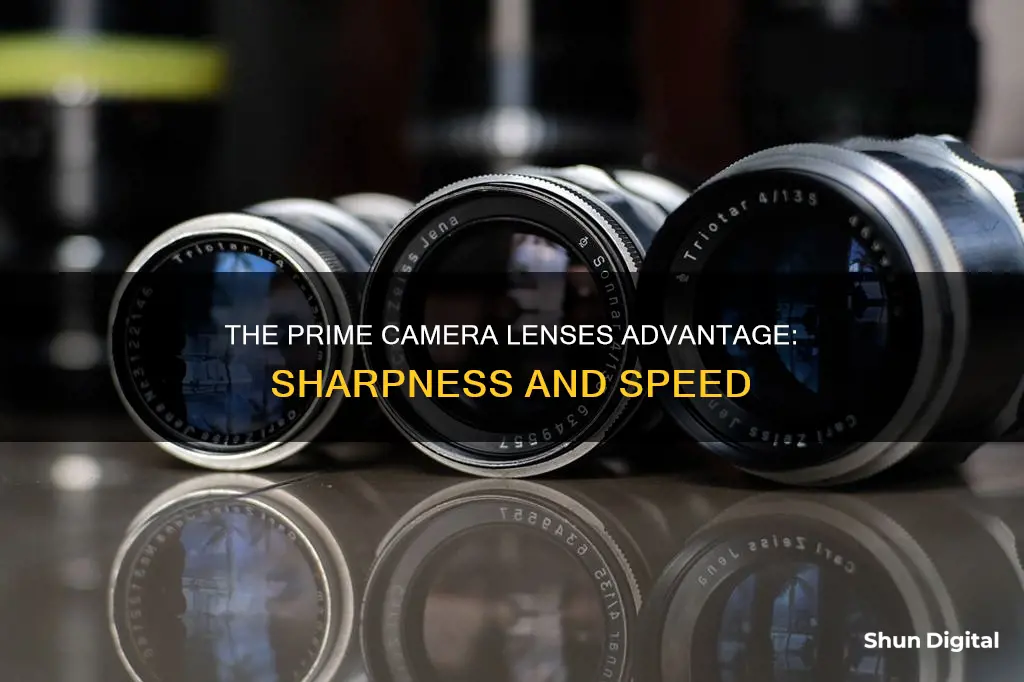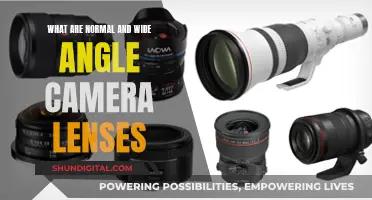
Prime lenses are a type of camera lens that has a fixed focal length, meaning the photographer cannot zoom in or out. Despite this limitation, prime lenses are popular among both enthusiast and professional photographers due to their simplicity, superior image quality, and versatility in different photography styles. They are also known for their fast apertures, which can create beautiful bokeh effects and improve low-light performance. Prime lenses are typically more compact and lightweight than zoom lenses, making them easier to carry and handle.
| Characteristics | Values |
|---|---|
| Focal length | Fixed |
| Zoom | Not possible |
| Aperture | Wide maximum aperture (e.g. f/1.8, f/1.4, f/1.2) |
| Image quality | Sharper, clearer, less distortion |
| Size | Smaller and more compact |
| Weight | Lighter |
| Price | Cheaper |
| Low-light photography | Better performance |
| Bokeh | Better |
| Shutter speed | Faster |
| ISO | Lower |
| Autofocus | Faster |
What You'll Learn

Prime lenses have a fixed focal length
Firstly, prime lenses are often smaller and lighter than zoom lenses, making them easier to carry and handle. They also tend to be cheaper, as they are much simpler to design and have fewer moving parts. Prime lenses also have a wider maximum aperture, such as f/1.4, f/1.8, or f/1.2, which lets more light into the camera. This results in better low-light capabilities and a shallower depth of field, which is ideal for portrait photography.
Additionally, prime lenses are known for their sharpness and superior image quality. With a simpler optical formula, prime lenses are optimized for a single focal length, resulting in sharper images with low levels of optical defects. They also have faster autofocus, making them suitable for capturing fast-paced events or moving subjects.
Prime lenses are also beneficial for improving your photography skills. The fixed focal length encourages photographers to be more intentional about composition, which can lead to more creative and engaging images.
The Ultimate Guide to Listing Camera Lenses Like a Pro
You may want to see also

They have a shallow depth of field
A prime lens is a fixed focal length lens that doesn't allow the user to zoom in or out. They have a shallow depth of field, which means that the plane of focus is narrow and everything outside of that plane is out of focus. This is achieved by using a wide aperture, which lets in more light and decreases the depth of field, increasing the background blur. The wider maximum apertures of prime lenses, such as f/1.8, f/1.4, and f/1.2, create a shallower depth of field than the apertures commonly found on zoom lenses, such as f/2.8 or f/4.
The shallow depth of field effect is not just about artistry. By blurring the foreground and background, the subject is emphasised, and the viewer knows exactly where to focus. This is particularly useful for portrait photography, where the emphasis may be on highlighting a particular feature, such as the eyes, or for event photography, where you may want to draw attention to a specific person or object.
The shallow depth of field also adds dimension to photographs. It can be used to direct the viewer's attention to what is important in the image, adding significance and depth to the photograph. It can also be used to defocus something to make the viewer wonder and pique their interest.
Another benefit of the shallow depth of field is that it allows the photographer to focus on what matters and blur out any unnecessary imperfections in the composition. This is especially useful when shooting outdoors, where there may be distractions in the background that take away from the main subject.
The shallow depth of field of prime lenses also has its challenges. It can be easy to overdo it, and relying too much on this technique may make images uninteresting. It is also important to ensure that the field of focus is wide enough and in the right place, so that the desired parts of the image are in focus.
Polishing Aluminum Camera Lenses to Shine Brightly
You may want to see also

They are small and light
Prime lenses are often smaller and lighter than zoom lenses. This is because they have a simpler design and fewer moving parts. The optical formula of a prime lens is simpler, and it doesn't need to move different elements around to change the focal length. This simplicity also means that prime lenses are generally cheaper to design and construct.
The compactness of prime lenses makes them easier to handle and more portable. They are also beneficial when travelling, as they are lighter and take up less space. The smaller size of prime lenses can also be an advantage when shooting discreetly in public areas.
While not all prime lenses are equally small and light, they are almost always more compact than their zoom counterparts. For example, the Canon EF 40mm f/2.8 Pancake Lens weighs only 4.6 oz (130 g) and has dimensions of 2.7 x 0.9″ (6.86 x 2.29 cm). This lens is so small it can fit in your pocket!
The size and weight of a lens setup can have a significant impact on the shooting experience. A lighter setup can make it easier to stay focused and improve your overall enjoyment of photography.
Adjusting Camera Lenses: The Ultimate Guide to Perfect Focus
You may want to see also

Prime lenses are cheaper
The affordability of prime lenses makes them attractive to beginners who are just stepping into the world of photography and looking to improve their skills without spending a fortune. An entry-level prime lens can offer great quality without a hefty price tag. For example, a 50mm f/1.8 lens can be purchased for between $100 and $300. This lens delivers crisp images and nice bokeh, all while being affordable.
Prime lenses are also ideal for travel photography, as they are compact and lightweight. They are perfect for discreet shooting and can fit easily into a pocket or handbag. Their lightweight design also makes them more comfortable to carry for long periods, which is beneficial for photographers who spend many hours on the job.
In addition to their cost and portability benefits, prime lenses offer other advantages over zoom lenses. They tend to let in more light, making them suitable for low-light photography. They also provide a shallow depth of field, allowing for dreamy bokeh backgrounds and artistic images with a sharp subject and blurred foreground and background.
While prime lenses have their advantages, it's important to consider their limitations. They lack the versatility of zoom lenses and require physical movement to change the composition. This can be a challenge in certain situations, such as sports events or small spaces, where the ability to quickly zoom in and out is crucial.
Fingerprints on Camera Lenses: Harmful or Harmless?
You may want to see also

They let in lots of light
Prime lenses are a popular choice among photographers, including professionals, due to their fixed focal length, which often results in a simpler design and superior optical performance. One of the key benefits of prime lenses is that they let in lots of light.
Prime lenses typically have a large maximum aperture, such as f/1.4, f/1.8, or f/1.2, which lets in more light. This feature is especially useful in low-light situations, as it allows for better low-light capabilities and a shallower depth of field. With a wider aperture, you can use faster shutter speeds and capture sharp images with less noise in low-light conditions. This makes prime lenses ideal for low-light photography, astrophotography, and event photography, such as weddings or concerts.
The large aperture of prime lenses also enables you to achieve amazing shallow depth of field and bokeh effects, enhancing the subject and creating a professional-looking image. The wider aperture blurs the background, allowing the subject to stand out and creating a dreamy, artistic look. This is particularly useful for portrait photography, as it emphasises the subject and creates a flattering perspective.
Additionally, the large aperture of prime lenses can help improve your compositions. With a shallow depth of field, you can blur the foreground and background, ensuring the viewer knows exactly where to focus. This technique can be applied to various photography styles, including portrait, landscape, and street photography.
In summary, the large maximum aperture of prime lenses, which lets in lots of light, offers several advantages. It enhances low-light performance, enables shallow depth of field and bokeh effects, and improves composition. These features make prime lenses a valuable tool for photographers, especially in low-light situations and when aiming for artistic, professional-looking images.
Projector Lenses: Can They Double as Cameras?
You may want to see also
Frequently asked questions
A prime lens is a fixed focal length lens that doesn't allow you to zoom in or out. They have very wide or large apertures, ranging from f/2.8 to f/1.2. Prime lenses are often smaller and lighter than zoom lenses, and they produce sharper images with better image quality.
Prime lenses offer several advantages over zoom lenses. They typically produce sharper images with less distortion and have a larger aperture, allowing for better low-light performance and a shallower depth of field. Prime lenses are also often more compact, lighter, and more affordable than zoom lenses.
Popular focal lengths for prime lenses include wide-angle options like 14mm-35mm, standard focal lengths like 35mm and 50mm, and telephoto options like 85mm and 135mm. The choice of focal length depends on the desired field of view and intended purpose, such as portrait, landscape, or street photography.







